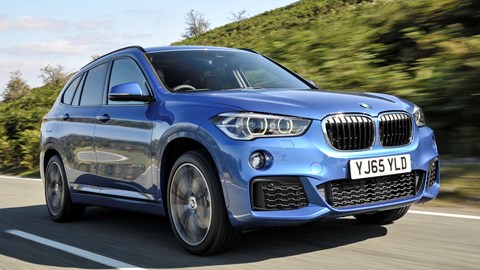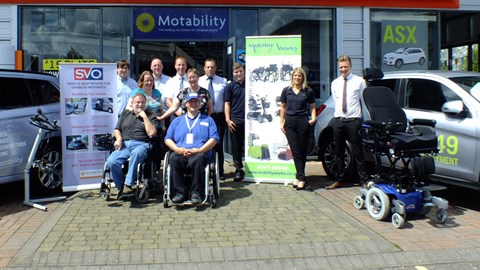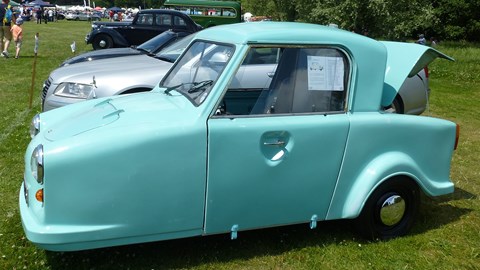► Motability is Europe’s largest fleet operator
► British charity supports 600,000 people
► Provides independence for disabled people in the UK
Motability is a British charity established in 1977 by Lord Goodman and Lord Sterling, and created in response to 1976’s new ‘mobility support’ benefit introduced by the DHSS. Although a welcome boost that enabled access to newly-introduced technology such as electric wheelchairs and scooters, as well as contributing to the use of public transport, it wasn’t enough to cover the costs of buying and running a car privately.
Prior to this, disabled drivers who were unable to afford an appropriate car had independence offered by a Government-issued ‘invalid carriage’ – a distinctive three-wheeled, rear-engined car that couldn’t take passengers and was powered by a motorbike engine. You can read a bit more about those below.
Compared with taking buses and taxis at the time, it was life changing.
Motability – from superminis, to specialist vehicles
It may not be the first thing to spring to mind for a car enthusiast as Motability is more frequently associated with wheelchair adaptations and automatic base-spec transport. But Motability probably knows cars better than most dealer or fleet organisations – it’s the largest fleet provider in Europe; with an extensive catalogue of over 1900 cars with pricing that few lease or PCP schemes could hope to match.
It’s not just the car that’s provided – Motability’s service is a fully maintained lease equivalent with comprehensive support; something that would be the envy of any company car driver.

In all cases, there are no ongoing monthly costs for the service user beyond fuel (or electricity – EVs have been offered since 2013). Maintenance, insurance, breakdown cover and wear items like tyres or wiper blades are all included in the 20,000 mile per year model.
Around 350 cars are offered with no initial payment required but where there is an extra cost, it’s generally far better value than PCP or leasing offers. Rather than penalising users for cars suffering the inevitable wear and damage of family use, gritted roads and crowded car parks, cars that are returned in good condition qualify for a bonus (at the time of writing, £600) when returned to the leaseholder; additional mileage charges are also fixed at 5p per mile.
You’re not limited to the specifications offered, but optional extras must be ordered and paid for up front. While haggling over a Motability car might seem odd, they are supplied via normal dealers, with normal margins (don’t be fooled – Motability’s edge comes from scale and tax advantages from the charitable status, not cut-price broker behaviour) and if you take a positive approach you may be able to negotiate around the up-front cost or extras.
People in genuine need and difficult circumstances may qualify for grants towards the up-front cost, so if your situation means a Mercedes Vito or similar is the only solution, it may be achievable despite the high up-front payment listed.
Who qualifies for Motability?
To qualify for the scheme, you will need to have an existing award for the mobility component of Disability Living Allowance (DLA), or have been awarded the Enhanced Rate, Mobility component of PIP – Personal Independence Payment. You also qualify if you’re in receipt of the War Pensioners’ Mobility Supplement, or Armed Forces Independence Payment.
If you’re the parent or guardian of a child over three in receipt of the higher rate mobility component of DLA, their allowance can be used for you to provide their transport.
These allowances are likely to be awarded if you or children you care for, have severe mobility issues (which can include some forms of mental illness as well as physical). However, they’re not just for permanent conditions – injuries with an extended recovery time will also qualify, so if you’ve suffered an injury and can’t drive your existing car you could consider storing it, rather than modifying it.
Everyone’s circumstances are different, so the best way to use the support may be very different for you – but if your motoring costs exceed around £240 per month (approximately the value of PIP), Motability is a very cost-effective solution.
Motability in numbers
- Started in 1978, now serves over 600,000 customers
- 4.5 million cars supplied to date
- £3.6 billion contributed to British car market
As well as the ebb and flow of conventional cars provided to meet the mobility needs of qualifying people, it also provides grants towards the substantial cost of wheelchair and accessibility adaptations for cars needed by disabled people in work, volunteer or carer roles. Given that it reaches customers via 5,000 UK dealers, Motability often supports the sort of small, family-focused rural showrooms that drivers would otherwise find disappearing in the face of larger, less personal groups.
Motability Operations is the contract provider for the fleet. Its turnaround of over 200,000 vehicles a year is a significant factor in new and used car sales. It’s profitable, too, thanks to the honed logistics and understanding of the market, Motability Operations returns a significant amount of income to Motability, the charity, as well as supporting outreach and educational programmes.

When returned, the cars are sold both through traditional auctions, and an innovative, award-winning online platform – https://www.mfldirect.co.uk/ – prices are visible only to registered dealers, but you can get an idea of the variety of cars on the scheme by browsing.
If you have a car you want to keep using, but require adaptations, Motability is also able to provide grants for these conversions – so that Alpina or Aston Martin doesn’t have to be left behind if your life changes direction.
Given the oft-derided state of welfare for those most in need in Britain’s current climate, Motability is a rare example of appropriate, flexible and generous life-changing support for people in genuine need.
Motability: further information
Motability leases run for three years, or five years for wheelchair-adapted vehicles, with an allowance of 20,000 miles per year. If you’ve used less than 15,000 miles you can extend the lease – as long as the car is in good condition.
Business use insurance is available, though not the default. As you’re paying for the fuel for your car, you can claim expenses in the normal way when using it for an employer; self-employed drivers should seek advice for the best approach for their car and circumstances.
I don’t qualify for Motability, what help can I get?
If you’ve been rejected for PIP (or DLA, where applicable) either due to the recovery prospects or nature of your condition, there are still routes for support when using your existing car, or covering the costs of an adapted vehicle.
Modifications for drivers may be available under the Access to Work scheme, though you will need to undergo assessment and the award will cover the business portion of vehicle use only. That same programme will cover the cost of your employer ensuring your working environment is safe, comfortable and appropriate, and will even – where necessary – cover transport if you’re unable to drive for an extended period and need to get to work.
The Invacar – 1945 to 1977
Once found in towns and cities across the UK, the Invacar was a post-war spark of genius that many would consider to have lasted far too long, such was its usefulness. Famously made by AC (the same AC that made rather beautiful sports cars, including the Cobra) as well as other contracted firms, it brought mobility to the disabled regardless of their financial means.
At a time when cars were astoundingly expensive and even into the 1950s and ’60s, drivers were hammering kit car bodies onto 1930s chassis to save money, the clever fibreglass trike was genuinely innovative and useful for a population returning from war with life-changing injuries. In a society with a less caring, understanding attitude to those born with severe conditions than we have now, this sort of gesture built the reputation of Britain’s health and welfare system around the world.

The Government scheme to provide cars to the disabled started in 1948 initially specified a fibreglass-bodied three wheeler powered by a 147cc engine and limited to 20mph (legally, not technically). By the 1970s the last-standing Thundersley Invacar gained a more powerful Steyr-Puch powertrain with CVT transmission, and in final form could reach 82mph.
Production ceased in 1977 – by which time mainstream cars had progressed significantly and become more accessible, too. Even so, it remained maintained and supplied by the British Government until 2003; not only were 200 were still in use, many more were stored in warehouses. All bar a handful in private ownership were scrapped – now, those survivors are legally allowed on the road as historic vehicles.
Although usually appreciated and loved (though sometimes, hated) by their users, the distinctive appearance (accompanied by a noisy, polluting and smoky two-stroke engine), occasionally nasty interpretation of them as a ‘handout’ and less evolved attitudes towards people with disabilities in the 1970s and ‘80s created a stigma around the cars. Sad to say, that attitude may remain in some quarters – but at least the cars those users receive now are no different to everything else on the road.
Check out more CAR motoring issues stories